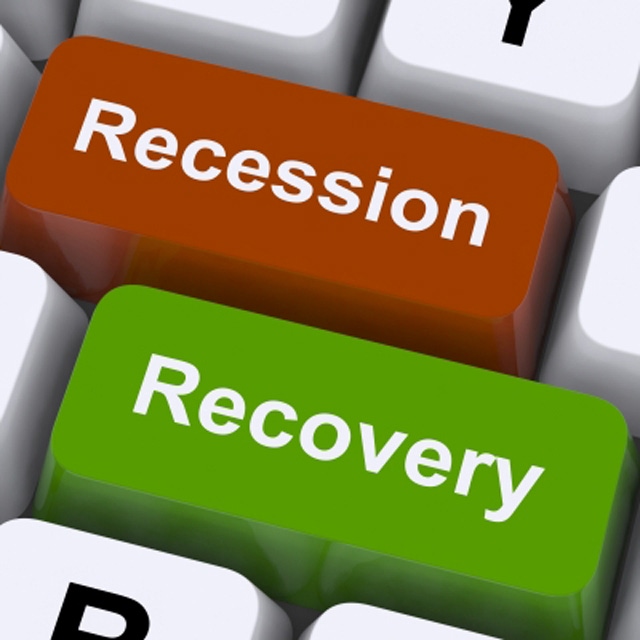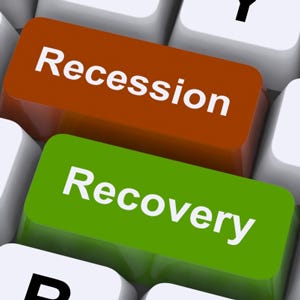Is Europe finally in recovery mode?
After five years of hard times, it does seem that things are finally looking up. According to the latest indicators and reports, the European Union is slowly emerging from an unprecedented period—in terms of both length and depth—of recession. The EU is on the right track, says the European Commission, but the recovery remains fragile. As the International Monetary Fund wrote following its consultation with the euro area in July 2014: “Real output has expanded for four consecutive quarters, and financial market sentiment has improved markedly . . .
December 19, 2014

After five years of hard times, it does seem that things are finally looking up. According to the latest indicators and reports, the European Union is slowly emerging from an unprecedented period—in terms of both length and depth—of recession. The EU is on the right track, says the European Commission, but the recovery remains fragile. As the International Monetary Fund wrote following its consultation with the euro area in July 2014: “Real output has expanded for four consecutive quarters, and financial market sentiment has improved markedly . . . but the recovery is neither robust nor sufficiently strong. Risks to growth are still tilted to the downside.”
|
Image courtesy Stuart Miles/freedigitalphotos.net. |
The ongoing process of de-industrialization throughout the EU zone has not helped. Europe has lost more than 6 million jobs since 2008, 3.8 million of which were in industry, while the EU unemployment rate hovers at an all-time high of almost 11%; in the eurozone, it is 12%. Belatedly, the realization has grown that the time has come, in the words of the Commission, for a “European Industrial Renaissance.” “The crisis,” commented the Commission in a communication with that title, ”has underlined the importance of the real economy and a strong industry. A strong industrial base will be of key importance for Europe’s economic recovery and competitiveness.”
Today, industry contributes some 15% to EU GDP. The goal now is to boost this to 20% by 2020, which will require addressing structural problems, such as unemployment and productivity. Fostering growth and competitiveness, which, in turn, will lead to more jobs, therefore top the priority list of the steps to be taken on the road to recovery. The impact of a strong manufacturing sector should not be underestimated: manufacturing has strong spillover effects on the rest of the economy and especially on overall productivity. “Eighty percent of private innovation, ¾ of export, and a substantial role in jobs creation come from industry. Nearly one in four private sector jobs is in industry, often highly skilled, while each additional job in manufacturing creates 0.5 to 2 jobs in other sectors,” wrote the Commission.
Meeting the challenge
It’s a fine ambition. The question is, however, how is the Commission going to go about achieving this? After all, there are still a number of obstacles that continue to stubbornly hamper EU growth. While internal demand has shown signs of coming to life, it remains weak, undermining European companies’ home markets. Rigid labor markets and inflexible administrative and regulatory environments work against growth, especially of small and medium-sized enterprises. In many sectors, investment in research and innovation is still on the back burner, holding back the necessary modernization of the industrial base and hampering future EU competitiveness. The growing skills mismatch is another challenge: Unemployment is high, yet at the same time, a shortage of skilled labor is starting to make itself felt. Access to affordable raw materials is becoming more difficult. And lastly, EU firms face significantly higher energy prices than most of their leading competitors, causing many to consider relocating to areas without this cost disadvantage.
The Commission has faced criticism from the market and from the European trade union, Industri-All, about the lack of concrete measures designed to combat these problems in order to reignite manufacturing in Europe. True, the member states have been called upon to work together in a coordinated, targeted manner: An integrated industrial policy approach has been developed, aimed at improving Europe’s competitiveness and increasing the region’s growth potential, ranging from stimulating investment in innovation and new technologies to smoothing the way toward a more integrated internal market. Funding, to the tune of €80 billion via the Horizon 2020 program, is being made available to stimulate investment in innovation and technology and to facilitate the commercialization of promising developments. Yet, more is needed than recommendations and joint programs. Critics have called for concrete measures such as targeted sector-specific and cross-sectorial industrial policy tools directed at creating and safeguarding jobs in European industry throughout the value chain; growth-oriented monetary, fiscal, and budgetary policies; and a responsible energy policy, to name but a few. These are needed in order to create the kind of level playing field that will bring Europe back into the competition, they say.
Upturn?
Uneven growth across the EU, and especially in the 18 countries in the euro currency zone, complicates the challenges that policy makers face. However, the latest figures appear to show that something, at least, is working.
The UK business lobbying organization, CBI, painted a glowing picture of manufacturing there in its quarterly trends survey for three months to July 2014, writing “firms are upbeat about the next quarter, with expectations for total new orders growth at their strongest since 1977, and export orders set to rebound.”
From Spain came the news that the GDP growth rates expected for 2014 and 2015 have been adjusted upward, to 1.3% in 2014 and 2% in 2015, 0.1 and 0.3 percentage points up on those previously projected.
And according to the purchasing managers index data published by Markit in July 2014, the recovery in the eurozone extended to the 12th successive month in June, although growth of output and new orders have slowed since May. In fact, “June saw manufacturing production expand at the lowest pace since September 2013,” wrote Markit, raising concerns that the recovery is losing momentum. As Evelyn Herrmann, European economist at BNP Paribas pointed out, the data “pose questions on the capacity for further growth acceleration in the eurozone in the second half of 2014.”
Plastics industry
What has this meant for the plastics industry? As might be expected, the European plastics industry has not escaped unscathed from the economic crises. Overall, the number of businesses active in the plastics industry—moldmakers, converters, and recyclers—has declined. As far as plastics production is concerned, the industry initially appeared to bounce back relatively quickly, although by 2011 a steady downward trend was becoming apparent that continued through 2012 and culminated that year in an overall contraction of polymer demand of just over 1%.
The market appeared to stabilize somewhat in 2013, leading PlasticsEurope, the European association of plastics manufacturers, to predict “a slow recovery” for 2014.
On the global level, Europe was the second largest plastics producer in 2013, accounting for 20% of the world’s total plastics production, just behind China, which remained in the lead with 24.8% of global plastics production. Plastics are an important export product for Europe, with demand for European primary plastics mainly coming from, for example, China, Turkey, Hong Kong, and Russia. At European level, however, demand for plastics in 2013 stood at 46.0 million metric tons, an increase of a mere 0.1% in comparison to 2012. And while packaging, next to building and construction, was one of the strongest markets, a recent market report from PCI Films Consulting revealed that the growth of Europe’s flexible packaging market tapered for the second consecutive year, to 1.3% both in value and volume terms in 2013, down from 2.1% and 1.8% respectively in 2012, due to declining demand. As Paul Gaster, author of the PCI report pointed out: “The growth slowdown reflects the fact that a number of economies in the eurozone are still struggling with the effects of recession, which has reduced demand for packaged foods in these countries.” According to this report, demand for flexible packaging in Italy, Greece, and Portugal continues to wane, while negative growth in France, one of the region’s most powerful economies, has slowed for the first time in four years. The UK and Germany continued to show growth, while demand was most encouraging in some emerging markets in eastern Europe, notably Russia and Poland, which grew at more than four times the European average. Turkey, however, experienced a drop in growth year-on-year.
PlasticsEurope described the current development of the European plastic industry as slow, but positive. However, the European plastics industry is facing significant worldwide competition, explained Karl Foerster, Executive Director of PlasticsEurope. “China continues to lead global plastics production and the U.S. has significantly reduced its energy prices, increasing their European competitiveness. These are only two examples of the challenges we have ahead.”
“To move toward a strong and competitive Europe, we need to ensure a long-term strategy for Europe’s re-industrialization. Policy makers need to ensure access to competitive energy and raw materials [and lend] support for innovation and training to provide skilled workforces to ensure a strong European plastics industry,” he added.
And the future?
The companies that have survived the past five years are leaner, tougher, and smarter than they used to be, and it looks as if their efforts are starting to pay off. As marketing intelligence firm AMI wrote in its 2013 European Plastics Industry Report, “the discipline of the downturn has made companies cut costs, preserve cash, and be judicious in their investments.”
As a result of technological innovations, the development of new materials, improved production and process efficiency, and new application gains, these survivors are starting to thrive. According to PlasticsEurope, Europe showed a growth of 6.6% for primary plastics, 7% for plastics products, and nearly 2% for the machinery sector for the period between January and February 2014.
It’s a good start, but that’s all.
As the AMI report also pointed out, there will “continue to be winners and losers across the European plastics industry,” predicting that demand will continue to shrink in the countries of southern Europe, hold steady in Germany and the north, and even grow in the central European region, depending on developments in the West. Taking all factors and trends into account, polymer demand growth beyond GDP growth rates, says the report, is not likely nor, as it now stands, is demand likely to reach the precrisis levels of 2007 before 2020, or perhaps even beyond.
About the Author(s)
You May Also Like


